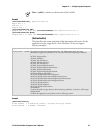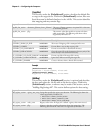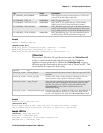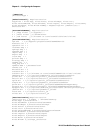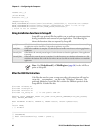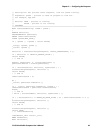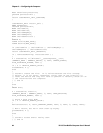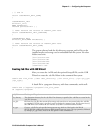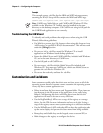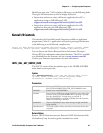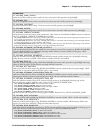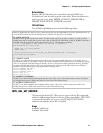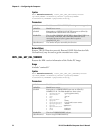
Chapter 3 — Configuring the Computer
751G Color Mobile Computer User’s Manual 65
} // end if
return codeINSTALL_EXIT_DONE;
}
codeUNINSTALL_INIT
Uninstall_Init(
HWND hwndParent,
LPCTSTR pszInstallDir ) {
// TODO: Perform the reverse of INSTALL_INIT here
return codeUNINSTALL_INIT_CONTINUE;
}
codeUNINSTALL_EXIT
Uninstall_Exit(HWND hwndParent) {
// TODO: Perform the reverse of INSTALL_EXIT here
return codeUNINSTALL_EXIT_DONE;
}
The system software looks for this directory structure and its files on the
installed media card storage card or embedded flash file system. No other
folders need exist.
\2577\autorun.exe
\2577\autorun.dat
\2577\autocab.exe
\2577\autocab.dat
\cabfiles\*.cab
Creating Cab Files with CAB Wizard
After you create the .inf file and the optional Setup.dll file, use the CAB
Wizard to create the .cab file. Below is the command-line syntax:
cabwiz.exe “inf_file” [/dest dest_directory] [/err error_file] [/cpu cpu_type
[cpu_type]]
A batch file in <program> directory, with these commands, works well:
cabwiz.exe c:\appsoft\<program>\<inf_file_name>
cd \appsoft\<program>
“inf_file” The Setup.inf file path.
dest_directory The destination directory for the .cab files. If no directory is specified, the .cab files are created in the
“inf_file” directory.
error_file File name for a log file that contains all warnings and errors that are encountered when the .cab files
are compiled. If no file name is specified, errors are displayed in message boxes. If a file name is used,
the CAB Wizard runs without the user interface (UI); this is useful for automated builds.
cpu_type Creates a .cab file for each specified microprocessor tag, which is a label used in the Win32
SETUP.INF file to differentiate between different microprocessor types. The /cpu parameter, followed
by multiple cpu_type values, must be the last qualifier in the command line.



